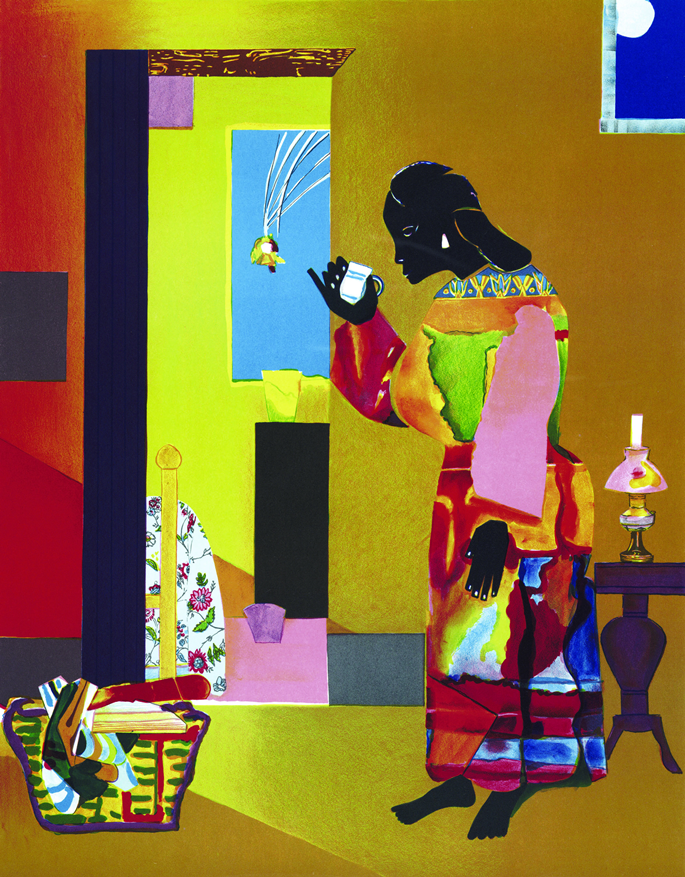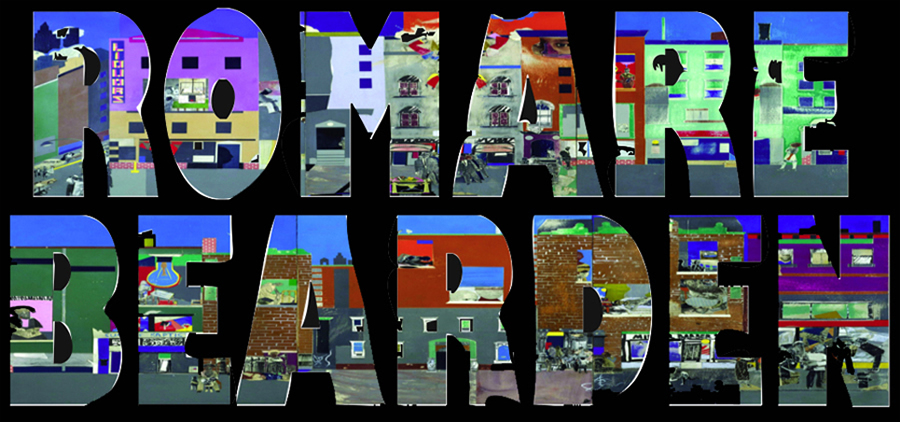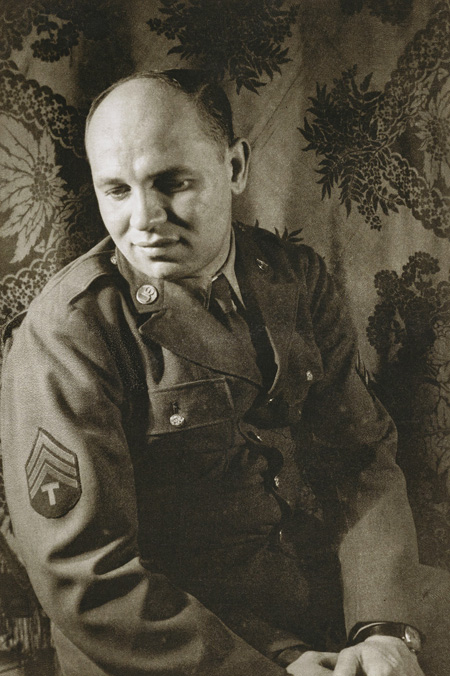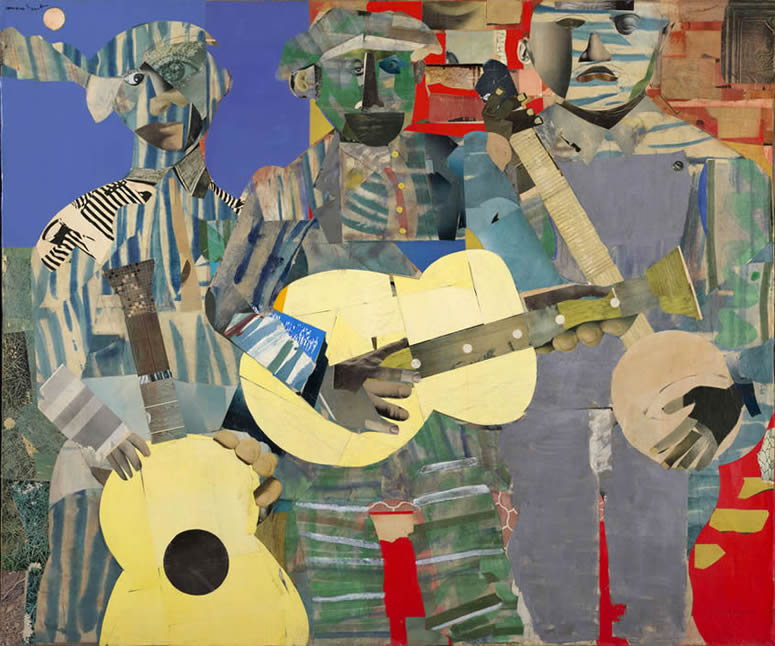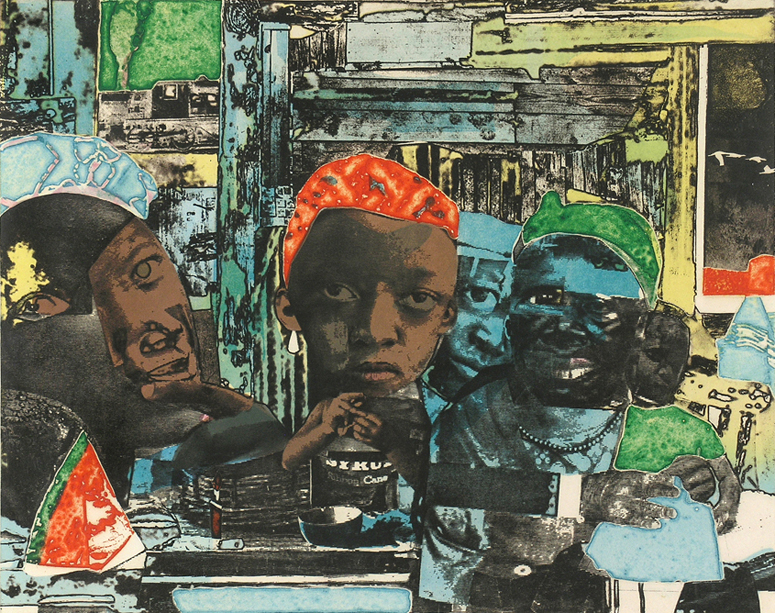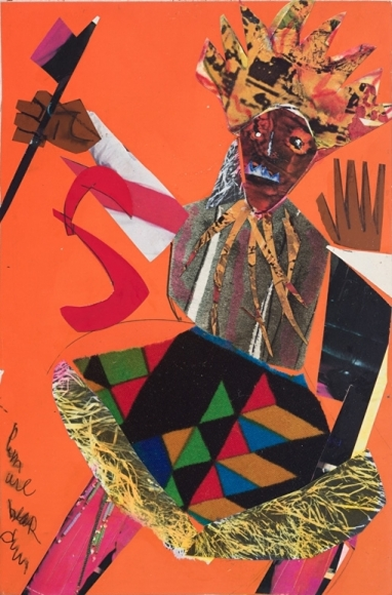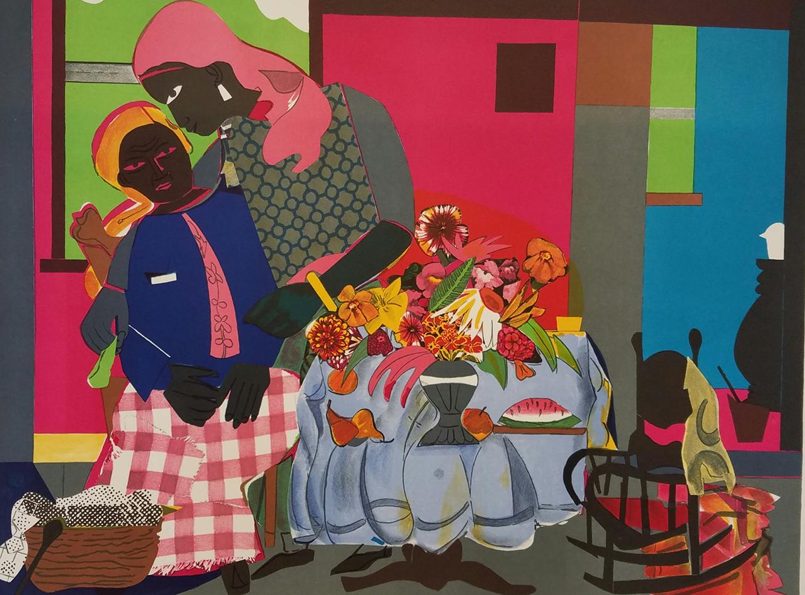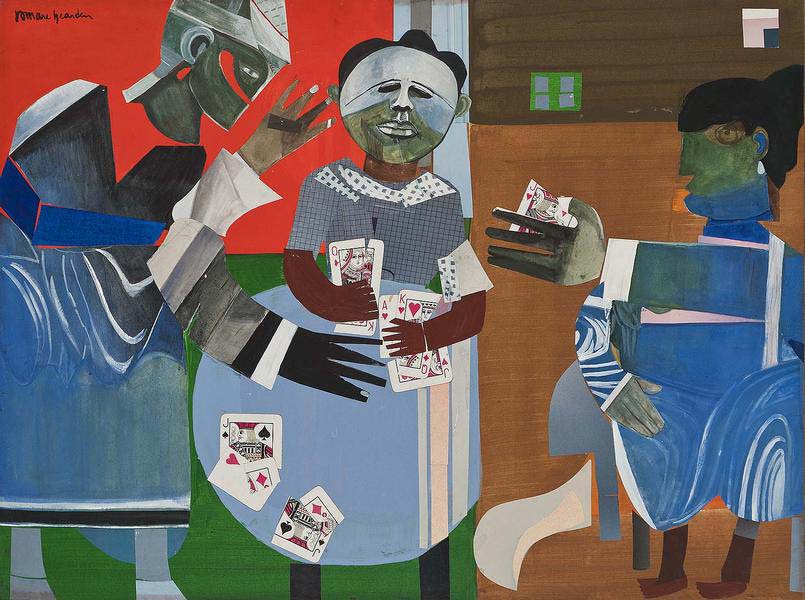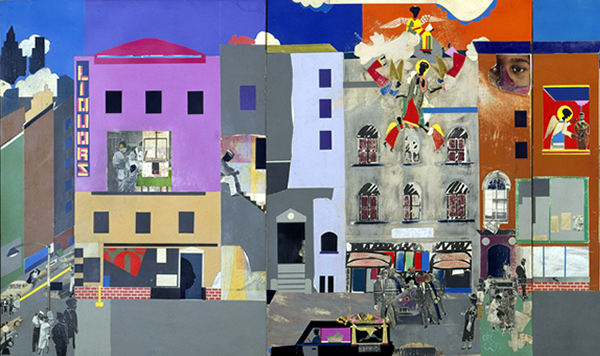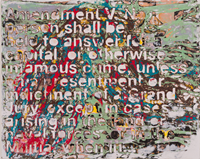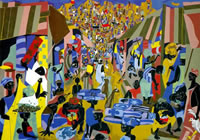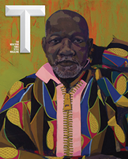|
|
|
|---|
Romare Bearden (1911 - 1988) is one of America’s most important artists. With technique, artistic mastery and a signature style, he single-handedly elevated the medium of collage and became the nation’s foremost collagist. Born in Charlotte, North Carolina, in 1911, he moved with his family to New York City at the age of three. His brief childhood in the South and return visits to see his great-grandparents, who were emancipated slaves, made a noteworthy impact on his art. Bearden’s collages, watercolors, oils, photomontages and prints are imbued with visual metaphors from Mecklenburg County, NC, Pittsburgh and Harlem and from a variety of historical, literary and musical sources. Incorporating hand-painted papers and photographs torn from magazines, his works present complex images of African American life from multiple perspectives.
This year has presented numerous opportunities to experience the work of one of the most creative and original visual artists of the twentieth century!
Edited by Janel St. John Falling Star, Romare Bearden, Painting, 1980, 28 x 21.5 in, , Lithograph Edition
|
|
|---|
TRENDING: 2017 Opportunities to experience a 20th-Century American Master |
|---|
Harlem Heroes: Photographs by Carl Van Vechten Now on view at The Smithsonian American Art Museum, through March, 19, 2017.
Here's an opportunity to see a portrait of the artist himself - Romare Bearden - captured in 1964. Author and social commentator Carl Van Vechten, (1880–1964) began taking photographs in 1932. For the next three decades, he made portraits of writers, musicians, athletes, politicians and others, many of them, central figures in the Harlem Renaissance, whose accomplishments transformed American culture throughout the 20th century. Other featured photos include Jacob Lawrence, James Baldwin, Ossie Davis, W.E.B. Du Bois, Ella Fitzgerald, Althea Gibson, Langston Hughes, Bill “Bojangles” Robinson, Bessie Smith and others. Some of the portraits capture their subjects on the cusp of success as they were full of ambition but before they became famous; others depict men and women looking back on long and varied careers. This installation features 39 images, spanning more than 30 years, documenting a vital aspect of the American Century. Part of the permanent collection - many of these photographs are on view for the first time since they were acquired.
|
Romare Bearden, from the portfolio 'O, Write My Name': American Portraits, Harlem Heroes 1944, printed 1983, Carl Van Vechten, (1880 -1964) photogravureimage: 8 5/8 × 5 7/8 in. Smithsonian American Art Museum, Transfer from the National Endowment for the Arts. Photograph © Van Vechten Trust; Compilation/Publication © Eakins Press Foundation. |
|---|
VMFA showcases Three Folk Musicians Now on view at Virginia Museum of Fine Arts, through March 6, 2017.
Three Folk Musicians, 1967, Romare Bearden (American, 1911-1988), collage of various papers with paint and graphite on canvas, 50 x 60 in. Art © Romare Bearden Foundation/Licensed by VAGA, New York, NY
If timeliness were an art form, the Virginia Museum of Fine Arts would be a modern master. VMFA has chosen Black History Month, to debut their brand new acquisition - Three Folk Musicians, by Romare Bearden. This large-scale collage – which depicts two guitar players and a banjo player – is frequently cited in art history books and has been featured in every Bearden retrospective. It’s now on view in the Mid to Late 20th-Century Galleries, through March 6, 2017. Bearden began making the brightly colored compositions depicting Black life, for which he has become best known, in 1963. That same year, he and a group of African American artists formed a collective known as Spiral to discuss their role in the civil rights movement. Their first meeting took place just one month before they attended the March on Washington for Jobs and Freedom on August 28, 1963. Scholars have identified the setting of Three Folk Musicians as the artist’s native Mecklenburg County, N.C. According to Bearden, the work also pays homage to a scene he often witnessed in his grandmother’s boarding house that he visited in Pittsburgh: “After supper, the boarders would sit in front of the house and talk, or play checkers, or plunk out ‘down home music’ on their guitars.” “Three Folk Musicians demonstrates how Bearden created visual correspondence for rhythm, syncopation, improvisation, and other musical sensibilities,” said Dr. Michael R. Taylor, VMFA Chief Curator and Deputy Director for Art and Education. “It thus honors the jazz and blues music that inspired African American artists – and modernists in general.”
Romare Bearden: Pictures of America Now on view at Taubman Museum of Art, through June 18, 2017.
PittsThe Train (detail), 1975, Etching with aquatint, 22 1/8" x 29 3/4”, Collection of the Taubman Museum of Art, Gift of the 1995 Collectors Circle, 1995.004, © Romare Bearden Foundation Taubman Museum of Art presents a spotlight exhibition on the work of renowned artist Romare Bearden. The complex and colorful art of Bearden is autobiographical and metaphorical. Rooted in the history of Western, African, and Asian art, as well as in literature and music, Bearden found his primary motifs in his personal experiences rooted in the life of his community. Romare Bearden: Pictures of America is curated by Amy G. Moorefield, Taubman Deputy Director of Exhibitions and Collections. It is one of two exhibitions featuring artists of color, currently on view at the museum. Follicular: The Hair Stories of Sonya Clark features the work of Richmond-based, multimedia artist Sonya Clark. Follicular, on view through May 14, 2017, explores the politics of hair as an indicator of race, social status, a symbol of age and authority, a statement of contemporary style, an object of beauty, and adornment.
Works of Romare Bearden: 1911 - 1988 Now on view at Charlotte Fine Art Gallery, through March 4, 2017.
Morning (Morning Carolina), Romare Bearden, 1979, Lithograph A hometown celebration - The Charlotte Fine Art Gallery presents Works of Romare Bearden: 1911-1988, a Black History Month exhibition. This celebration of the country's foremost collagist, includes over 45 limited edition/signed and numbered prints available for collection, as well as some pieces from a private collection. Born to (Richard) Howard and Bessye Johnson Bearden in Charlotte, North Carolina, Bearden is best known for his collages. He also created paintings in oil and gouache, watercolors and drawings; photographs, monotypes, and edition prints; designs for record album covers, book illustrations, and the ballet.
Two Group Shows
The Gamble, Romare Bearden, 1968 mixed media collage of various papers, gouache, watercolor and playing cards on Masonite
|
|---|
A Lifetime of Artful Impact 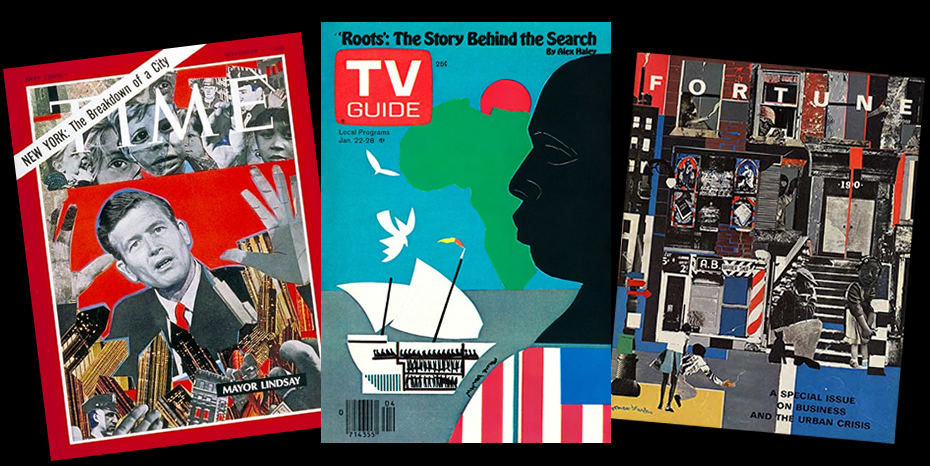 |
|---|
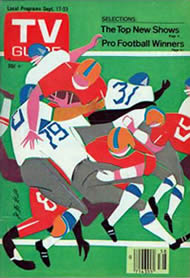 |
With pictures lifted from magazines and art books, Romare Bearden created rich, inventive and layered compositions that confounded the notions of “black” art as a fixed style or set of ideas. With source material from the magazine inside, he was soon granted access to the outside. January 1968, he was asked to illustrate the cover of FORTUNE. Original credit: For this special issue, Fortune commissioned Negro artist Romare Bearden, fifty-three, to convey his own mood of urban life. What Bearden pieced together is the striking collage on the cover. Bearden knows the neighborhood signposts well; he grew up in Harlem. He serves as art director of the Harlem Cultural Council, which seeks to encourage promising Negroes in the arts. For Bearden, the assignment was reminiscent of an earlier one. In 1942, he painted a picture to accompany a Fortune article on an all too familiar subject: the Negro and discrimination. Cover Illustrator of the Day: Romare Bearden. That same year, Bearden illustrated the November 1968 cover of TIME Magazine, and a decade later, two covers for the largest American weekly - TV Guide. The Jan. 22-28, 1977, issue featured “Roots,” the biggest television event in history and the Sept. 17-23, 1977, edition was an NFL season preview. |
|---|
The Making of A Master Bearden had a prolific and distinguished career. Also a writer, and a social organizer, his lifelong support of young, emerging artists was legendary. Yet forging an artistic career was a long and bumpy road. He paid incredible dues, working full-time as a case worker in the New York City Social Services Department, for almost three decades, until he was in his late 50s. His studio time, apart from occasional breaks, was only at night and on weekends. He experimented with many different mediums and artistic styles and was recognized as a professional artist during his first solo exhibition in Harlem in 1940. Four years later, he had another solo show in Washington, DC. But in 1949, he suffered a major crisis of confidence, when his New York art dealer, Samuel Kootz, dropped from his roster. Kootz was intending to ride the popular Abstract Expressionism wave and didn’t find Bearden’s work to be abstract enough. But in the 1960s, piece by piece, Bearden began to collage. And the rest – as they say – is history. On Bearden’s 100th birthday, in 2011, the world stopped on its axis for the Bearden Centennial - a celebration of the man who became an American master. Bearden's work has been the subject of numerous retrospectives and is included in many important public collections. The Mint Museum has one of the nation’s largest public collections of his works and they have a gallery exclusively devoted to him. In 2013, the City of Charlotte opened The Romare Bearden Park, a public park in his name. |
|---|
In 1978 Bearden created an iconic work - an 18-foot mural celebrating Harlem called The Block. (Detail right) You can see the entire work, from our About page. Better yet, from this Met Museum feature : Modern Storytellers: Romare Bearden, Jacob Lawrence, Faith Ringgold The Block, Romare Bearden, Six panels, each: 48 x 36 in. Cut and pasted printed, colored and metallic papers, photostats, pencil, ink marker, gouache, watercolor, and pen and ink on Masonite. Gift of Mr. and Mrs. Samuel Shore, 1978 © Romare Bearden Foundation/Licensed by VAGA, New York, NY |
|
|---|---|
Bearden continues to be a major influence on artists to this day. When The Roots released their 11th studio album in 2014, they chose Pittsburgh Memory, (right) a renowned Bearden collage for the cover art. Pittsburgh Memory, Romare Bearden, 1964 |
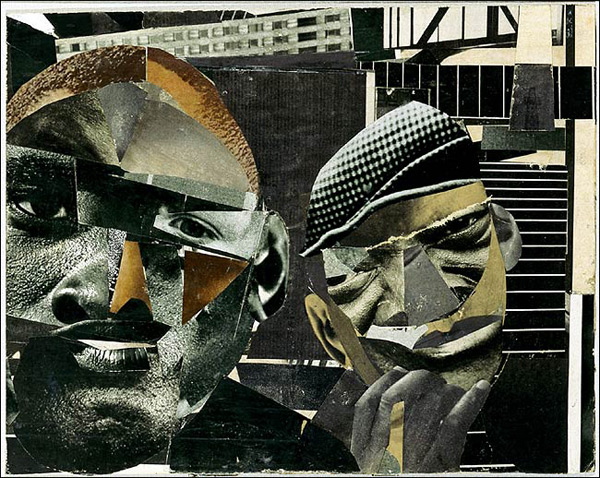 |
The Early Years Bearden began college at Lincoln University, transferred to Boston University and completed his studies at New York University, graduating with a degree in education. While at NYU, he took extensive courses in art and was a lead cartoonist and then art editor for the monthly journal The Medley. He had also been art director of Beanpot, the student humor magazine of Boston University. Bearden published many journal covers during his university years and the first of numerous texts he would write on social and artistic issues. He also attended the Art Students League in New York and later, the Sorbonne in Paris. In 1935, Bearden became a weekly editorial cartoonist for the Baltimore Afro-American, until 1937.
In 1954, Bearden married Nanette Rohan, with whom he spent the rest of his life. In the early 1970s, he and Nanette established a second residence on the Caribbean island of St. Martin, his wife's ancestral home, and some of his later work reflected the island's lush landscapes. Among his many friends, Bearden had close associations with such distinguished artists, intellectuals and musicians as James Baldwin, Stuart Davis, Duke Ellington, Langston Hughes, Ralph Ellison, Joan Miró, George Grosz, Alvin Ailey and Jacob Lawrence. During his lifetime, Bearden's work was exhibited throughout the United States and Europe. In 1973 he received an Honorary Doctorate in Fine Arts from Pratt Institute, Brooklyn, New York. It would be one of many. He received the Mayor's Award of Honor for Art and Culture in New York City in 1984 and was presented the National Medal of Arts by President Ronald Reagan in 1987. In 2011, he was honored by the U.S. Postal Service on a set of four Forever stamps. "Six Black Masters of American Art," coauthored with Harry Henderson (1972) is among the numerous books he authored. "A History of African American Artists: From 1792 to the Present," was coauthored with Harry Henderson and published posthumously in 1993. FULL BIO on Bearden Foundation. |
|---|
|
|
MARK BRADFORD |
YAYOI KUSAMA |
|||
|---|---|---|---|---|---|---|
|
JACOB LAWRENCE |
|
KERRY JAMES MARSHALL |
DESIGN AWARDS |
|||
|


